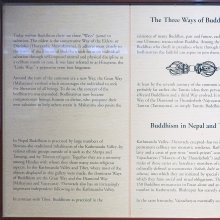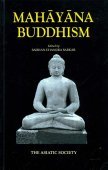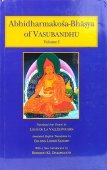Hinayana, Hīnayāna, Hina-yana: 10 definitions
Introduction:
Hinayana means something in Buddhism, Pali, Hinduism, Sanskrit. If you want to know the exact meaning, history, etymology or English translation of this term then check out the descriptions on this page. Add your comment or reference to a book if you want to contribute to this summary article.
Images (photo gallery)
In Buddhism
Theravada (major branch of Buddhism)
Source: Access to Insight: A Glossary of Pali and Buddhist Terms"Inferior Vehicle," originally a pejorative term - coined by a group who called themselves followers of the Mahayana, the "Great Vehicle" - to denote the path of practice of those who adhered only to the earliest discourses as the word of the Buddha. Hinayanists refused to recognize the later discourses, composed by the Mahayanists, that claimed to contain teachings that the Buddha felt were too deep for his first generation of disciples, and which he thus secretly entrusted to underground serpents. The Theravada school of today is a descendant of the Hinayana.Source: Dhamma Dana: Pali English GlossaryM (Bad (hina) ; vehicle (yana).) "The vehicle of the bads", Sect of bad monks whom diverged from sangha by their loosening, laxity. (So, the monks of hinayana are against the ones of theravada)
See also: What is the difference between "hinayana" and "mahayana"?
Theravāda is a major branch of Buddhism having the the Pali canon (tipitaka) as their canonical literature, which includes the vinaya-pitaka (monastic rules), the sutta-pitaka (Buddhist sermons) and the abhidhamma-pitaka (philosophy and psychology).
Mahayana (major branch of Buddhism)
Source: academia.edu: A Study and Translation of the GaganagañjaparipṛcchāHīnayāna (हीनयान) refers to the “small vehicle”, according to the Gaganagañjaparipṛcchā: the eighth chapter of the Mahāsaṃnipāta (a collection of Mahāyāna Buddhist Sūtras).—Accordingly, “[...] Thus he becomes one who subjugates the works of Māra (mārakarman). What then is the subjugation of the works of Māra? That by means of which none of Māra can find a weak point in the Bodhisattva. (1) Seeking the small vehicle (hīnayāna-spṛhaṇatā) is the work of Māra; (2) not keeping the thought of awakening is the work of Māra; (3) discriminatory giving to living beings is the work of Māra; (4) morality based on social class is the work of Māra; [...]”.

Mahayana (महायान, mahāyāna) is a major branch of Buddhism focusing on the path of a Bodhisattva (spiritual aspirants/ enlightened beings). Extant literature is vast and primarely composed in the Sanskrit language. There are many sūtras of which some of the earliest are the various Prajñāpāramitā sūtras.
General definition (in Buddhism)
Source: archive.org: The Indian Buddhist Iconography (b)Hīnayāna (हीनयान) refers to the Śrāvakayāna and the Pratyekabuddhayāna, both referring to Buddhist paths (yāna).—Lord Buddha prescribed Yānas in the beginning, namely, the Śrāvakayāna and the Pratyekabuddhayāna. [...] Buddhism continued in this state till the rise of the Mahāyāna properly called, the Bodhisattvayāna. The Mahāyānists dismissed the previous Yānas with the contemptuous epithet of Hīnayāna. They claimed that they could not only attain Nirvāṇa, nay even Buddha-hood,with their own unaided efforts, but could also help others to attain these ideals. The distinction between Mahāyāna and Hīnayāna is graphically described in the earliest work, the Mahāyānasūtrālaṃkāra, attributed to the famous Buddhist sage Asaṅga.
Source: Shambala Publications: GeneralHīnayāna Skt., “Small Vehicle”; originally a derogatory designation used by representatives of the Mahāyāna (“Great Vehicle”) for early Buddhism. The followers of Hīnayāna themselves usually refer to their teaching as the Theravāda (Teaching of the Elders), although strictly speaking, Theravāda was one of the schools within the Hīnayāna; it is, however, the only one still existing today. Hīnayāna is also referred to as Southern Buddhism, since it is prevalent chiefly in countries of southern Asia (Sri Lanka, Thailand, Burma, Kampuchea, Laos).
The Hīnayāna school developed between the death of the Buddha and the end of the first century BCE. According to its adherents it represents the original, pure teaching as it was taught by the Buddha. Its doctrines are essentially based on the sūtras, which are said to have been spoken by the Buddha himself. [...] The Buddha is regarded by these schools as a historical person, an earthly man and teacher, not as a transcendent being. The essence of the teaching is expressed in the four noble truths, the doctrine of dependent arising (pratītya-samutpāda), the teaching of anātman, and the law of karma. The basic practice of the Hīnayāna is described in the teaching of the eightfold path.
Languages of India and abroad
Sanskrit dictionary
Source: DDSA: The practical Sanskrit-English dictionaryHīnayāna (हीनयान).—Name of the earliest systems of Buddhist doctrine.
Derivable forms: hīnayānam (हीनयानम्).
Hīnayāna is a Sanskrit compound consisting of the terms hīna and yāna (यान).
Source: Cologne Digital Sanskrit Dictionaries: Edgerton Buddhist Hybrid Sanskrit DictionaryHīnayāna (हीनयान).—(nt.), the inferior vehicle, i.e. that of the śrāvakas: Mahāvyutpatti 1253; depreciated, na °yānena nayanti buddhāḥ Saddharmapuṇḍarīka 46.14 (verse); others, see s.v. yāna.
Source: Cologne Digital Sanskrit Dictionaries: Monier-Williams Sanskrit-English DictionaryHīnayāna (हीनयान):—[=hīna-yāna] [from hīna > hā] n. ‘simpler or lesser vehicle’, Name of the earliest system of Buddhist doctrine (opp. to mahāyāna; See yāna).
[Sanskrit to German]
Sanskrit, also spelled संस्कृतम् (saṃskṛtam), is an ancient language of India commonly seen as the grandmother of the Indo-European language family (even English!). Closely allied with Prakrit and Pali, Sanskrit is more exhaustive in both grammar and terms and has the most extensive collection of literature in the world, greatly surpassing its sister-languages Greek and Latin.
Kannada-English dictionary
Source: Alar: Kannada-English corpusHīnayāna (ಹೀನಯಾನ):—[noun] earlier of the two prominent schools of Buddhism, still prevalent in Sri Lanka, Burma, Thailand, and Cambodia, stressing the original monastic discipline and attainment of salvation by meditation.
Kannada is a Dravidian language (as opposed to the Indo-European language family) mainly spoken in the southwestern region of India.
See also (Relevant definitions)
Starts with: Hinayanasprihana.
Ends with: Abhinayana, Dakkhinayana, Dakshinayana, Rauhinayana, Ravishashinayana, Shikhinayana, Shlokabhinayana.
Full-text (+63): Mahayana, Theravada, Shravaka, Vaibhashika, Shravakayana, Shravakavinaya, Vasubandhu, Twenty Hinayana Sects, Kashyapiya, Samprakashanata, Mulasarvastivada, Bhadrayaniya, Sannagarika, Nihsriti, Pali, Avarasailah, Kaukkutikah, Haimavata, Four Hinayana Sects, Sammitiya.
Relevant text
Search found 58 books and stories containing Hinayana, Hīnayāna, Hina-yana, Hīna-yāna; (plurals include: Hinayanas, Hīnayānas, yanas, yānas). You can also click to the full overview containing English textual excerpts. Below are direct links for the most relevant articles:
The Three Vehicles Of Buddhism (by Kensur Lobsang Chojor)
Buddha-nature (as Depicted in the Lankavatara-sutra) (by Nguyen Dac Sy)
Introduction (Hīnayāna and Hindu philosophy) < [Chapter 3 - The Laṅkāvatārasūtra and Hindu Philosophy]
Introduction to Chinese Buddhism < [Chapter 6 - Further Development of the Thought of Buddha-nature in China]
1. Traces of the Buddha-nature in Early Buddhism (Introduction) < [Chapter 1 - Evolution of the Buddha-nature Concept]
Vimalakīrti Sutra (by John R. McRae)
Chapter III - Disciples < [Fascicle One]
Folk Tradition of Bengal (and Rabindranath Tagore) (by Joydeep Mukherjee)
Stupas in Orissa (Study) (by Meenakshi Chauley)
Orissa During the time of Harshavardhan < [Chapter 2]
During the time of Asoka (third century BCE) < [Chapter 2]
During the Kushana Period < [Chapter 2]
Related products





